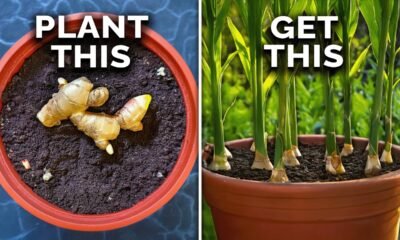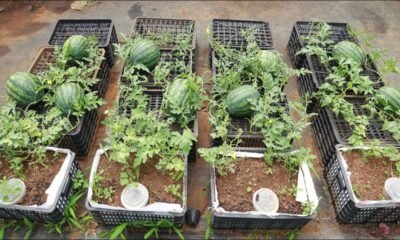7 Pests You Probably Have In Your Garden (And What To Do)
– Spring is here, and if it’s not, it’s coming soon. So in this video, Jacques and I are gonna go over seven of the most common pests you’ll see this season and how to prevent them. – There’s probably no pests more iconic than the aphid. It’s the bane of every gardener’s existence, comes in on your plants and starts sucking the life out of it and slowly killing it over time.
There are over 250 different types of aphids.
They have a little pear-shaped body, and they could even fly as adults. So they’re pretty formidable in terms of pest world, and they can actually overwinter in your mulch and different plants around your yard, only to come back when they sense something to feast on. So what is the damage that you would expect to see from aphids? Well, you’ll see leaf curl, yellowing leaves, maybe drooping and wilting.
There’ll definitely be some sort of scarring and damage done on the plant.
And I actually pride myself for not having aphids on my kale. But we’ve had so much rain this year that the soil right here almost never gets sun and it is entirely soggy. So that’s actually one of the main ways that you could get aphids, it’s from having stressed plants. There’s many different ways to stress plants, whether it’s too hot, too much water, not enough water.
But generally, the most common case for getting aphids on your plants is over-fertilizing, specifically nitrogen.
They usually concentrate on the youngest, most tender growth on a plant. So if you over fertilize your plant, you’ll end up getting all these new growth and soft tissue that the aphids will absolutely feast on. Another thing that’s really common with aphids is that you’ll generally find ants alongside them.
And it’s because the ants are using the aphids as a literal farm. The aphids will produce something called honey dew, which is a sugary substance that the ants will collect.
This honey dew can also build up on your plant and actually cause a kind of black fungusy, mold-looking surface to your leaf that can also cause damage to your plant. So how do we actually get rid of these? There’s quite a few ways. One of the most easy one is if you have a bunch of leafs covered in aphids, just go ahead and rip them off, and the plan will regenerate hopefully with less aphids. Now, another one is something that’s really low-tech and everybody has on hand.
So my favorite low-tech solution is a hose, and I like to use the cone setting ’cause it makes a really powerful sort of water blast.
Just come in at the top and literally blast away the aphids and they won’t stand the chance. They’re so small, by the time they get back up here, they’ll probably die. So it’s a good way to deal with it, especially when you combine it with hard pruning. So my kill might look really funny right now, but now these new leaves will be able to grow without any aphid pressure.
Beyond using something like pruning or the hose, you could attract beneficial insects like lady beetles, hoverflies, parasitic wasps by growing things like dill, flowers, calendula, things like that that they like to colonize in.
There are also some sort of sprays you could use, things like Neem, but generally I would recommend trying to just physically control it by spraying your plant and stopping the problem in the first place by not over-fertilizing. – If you’re an indoor seed-starter or a house plant lover or in a greenhouse, fungus gnats are the next most common thing you’re going to deal with.
And they’re just in environments like these, primarily because they love damp soil, consistently damped soil, unprotected soil, much like you see here in our seed-starting trays. And they like stagnant water, sort of stable conditions like that.
And there’re gonna be these little tiny gnats or tiny, tiny little flies, 16th of an inch, maybe up to a half an inch at best, and they can wreck havoc on your plants. So what they’ll do is they will lay their eggs sort of just below the soil surface in, say, a tray like this. And then the larva, which are these tiny little white larva, will feed on the roots, and they actually carry a ton of different diseases the adults do. So they can infect with verticillium, fusarium, all these sort of common plant diseases. So control-wise, predatory mites are a good option, and beneficial nematodes also.
But to be honest, one of the most effective things that I’ve ever seen, especially when you’re growing in an indoor environment and you don’t care so much about preserving all the different qualities of the soil, you just want to kill off the fungus gnats, is to get a product called Mosquito Dunks.
Basically an organic pesticide called BT, bacillus thuringiensis. It’s a specific variety. I think israelensis is the one. But either way it is a completely organic way to take care of the fungus gnats.
And the way it’s gonna work is you’re going to grab a watering can, throw a mosquito dunk in there, let it soak for a little bit, and then come over the top of your plants and water the entire affected area.
The reason this works so well is because all the larva have to do is get a little bit of that bacterium inside of them, and it will completely kill them off. So while you can throw mulch on top and try to bury the soil a little bit, to me the guaranteed foolproof way to deal with it, especially in an enclosed environment like a greenhouse or indoors, is to just water it with this Mosquito Dunk product. – If you’ve grown cabbage or even actually any brassica before only to finally your leaves are full of holes, then you’ve probably experienced the cabbage warm or the cabbage looper.
Both of these are attracted to brassicas, and they’ll start showing up when the temperatures rise, which is why actually in San Diego we’ve started growing all of our brassicas in the late fall and spring to avoid it entirely.
But let me show you how to identify the two, and we’ll talk about how to treat them. On this cabbage right here, we actually have a cabbage worm, and that comes from the little white butterfly with black spots on it, and it’s actually quite the menace. It’ll eat holes through your entire cabbage down to the core of the plant. And then there’s also the cabbage looper, which comes from a moth that has kind of an appearance similar to a tree bark. Both of them work the same way.
They come onto your leaves and they eat through it, pooping all over it and making all these holes, and sometimes even stunting your plant.
So how do you treat them? In terms of beneficial controls, you can try to attract beneficial wasps to your garden. You could also plant things like sage to try to mask the smell of your brassicas. And honestly, the best thing is birds.
So if you have a wide variety of native shrubs and plants, then the birds will be attracted to your garden and hopefully pick some of these off. And the same goes for any sort of pesticides we might want to use. Most popular is probably bacillus thuringiensis or BT. It’s a type of bacteria that once the caterpillar will eat, will tell it that it’s full and then it’ll essentially die. That’s a good one because it doesn’t cross over to affect as many other insects.
So it’s kind of safer. But if you do have something like spinosad, that’ll also work as well as any kind of broad spectrum pesticides. – Over here in the citrus orchard, a common problem can be leaf miners. And of course, they don’t just affect citrus, they affect all sorts of different plants. On this particular citrus, my Bearss lime, they aren’t affecting it at all.
It’s gone through a season, they’re finally off this plant. But if we come over here to my blood orange, I’ve got a telltale sign, and this is how you know you’ve got them. If you take one of these leaves and you come in here and take a peak, you see this sort of spiral or winding path. And this one’s even a little bit old. They’re not currently in this plant, but this is the sign.
It’s very, very obvious. Perhaps one of the easiest pests to identify because of that sort of spiraling path.
And what’s really going on there is an adult, whether it be a moth, there’s a couple of other different species of soft fly that can do this, they’ll come in, they’ll lay their eggs, oftentimes on the underside of the plant and on the leaf tissue, and then that will hatch and the larva will literally burrow in between the top and bottom. So they’re inside the actual tissue of the leaf, leaf miner. They’re sort of boring their way through the central tissue and they kind of just wander around, eating whatever they want.
And this can cause a lot of different problems, especially on younger, more sensitive leaves which are easier to penetrate into.
Leaf miners can decimate a crop. You can see you’ll get this sort of curl. And what’s happening there is they’ve killed all the tissue and it’s kind of tightened that piece of it up and forced it to kind of curl in and die. Now, on citrus it’s not a huge deal because typically you just sort of let it go.
And as you can see in the years to come, they’re able to fight it off as the plant gets more mature. But there are some great prevention options. So you can actually just squish the leafs, obviously without removing it from the plant. This would be your hand control option. If you have a small amount of leaf miners come in and just do that, and they will smoosh, the larva will smoosh inside the leaf.
There are some other controls. You can do parasitic wasps and beneficial nematodes. Personally, when it comes to adding an environmental organism, like adding a new bug in there, I’d rather just cultivate an environment in which the bug is more likely to be, and then I’ll go with more manual control options. So if I really was trying to get crazy and protect my citrus here, I would probably use some kind of floating row cover while the citrus was young. Now, I don’t think it’s that big a deal in this particular case, but you might over in the vegetable garden, if you’re dealing with leaf miners.
If you do want to go with a spray, BT spray works really well because it works on most of these larval forms of insects. And then you can also go with a spinosad spray as well. – This next pest is one that you’ve probably never actually seen in action, but you’ve almost certainly seen the results of its damage. And that is a cutworm. Cutworms have a very large family of different types of cutworms.
There’s kinds that’ll actually come up into your plant and eat your fruit. But in this case I’m talking about the ones that live in your soil and decapitate your seedlings.
The reason why you’ve probably never seen this pest in action is ’cause it comes up out of the soil at night and this is exactly what it does. So you put the seedling in the daytime, and then at night it comes up out of the soil and it bites the first thing it sees. Just like that.
You come out the next morning and you see your seedling with its main stem and the plant itself on the ground, and just a little stub of your seedling leftover. So we’ll put up some examples of what they look like on the screen, but this is one of the most common symptoms you’ll find, is a decapitated seedling. And the reason why you don’t see it is ’cause it only comes out at night. So what can you do to actually prevent this? Well, one of the classics that people often recommend is that when you plant your seedling, find yourself a stick and put it right next to your seedling.
Or better yet, take a couple sticks and put it there. What’ll happen is the cutworm will come out, bite the stick, realize it’s hard, back out, and look for a different plant. Some people also put foil rings around, but those are kind of the most direct physical controls you could do. If you wanna try to treat the whole problem itself, you can get beneficial nematodes that’ll come into your soil and parasitize those cutworms and kill them for you. The other option is, if you know that they’re concentrated in an area, it’s a good time to actually go through and till it.
Tilling it will kill all of them on contact ’cause it’s just going to basically shred them apart. – A little bit less common, but nevertheless still quite destructive are thrips. They look like little pieces of rice, but they’re yellow or black in appearance, sort of a weak insect. They can fly but very, very lightly.
They sort of use a weirder mechanism to fly than just flapping their wings.
But thrips can be quite destructive. They’re gonna eat the leaves and/or the fruit. And they also can spread specific viruses. So what you’ll see is like a silvery, papery leaf. If a thrip has been by, you’ll see like a yellow modeling on the leaf.
Sometimes you’ll even see them on the plant, although it’s personally a little bit less common for me to see them. I just have other pests in my garden. For beneficials that will decimate thrips, you’ve got your classics. You’ve got green lacewings, you have pirate bugs, you have parasitic wasps, and predatory mites. But then again, you also want to think about some manual control.
The triple threat of control here is going to be Neem oil, which we have a full guide on how to use properly in your garden. Then you have a more serious one, which would be a pyrethrin spray. I would only use that in the case of a very severe infestation. Thrips can kind of clump together and get a little crazy.
Sometimes you have to go with that more extreme route.
And then you can also go with the tried and true BT spray. – The next one we’re going to talk about is whitefly. And that’s why I’m standing here next to this huge shrub or hedgerow, because I find that whitefly tends to love living in situations like this, where they have a sort of controlled temperate climate. Now, what’s the way to tell that you have whiteflies? Well, if you move your plants and all of a sudden you see a bunch of white, tiny little moth-like creatures fly at you, you probably have whitefly.
And then when you go and look at the undersides of your leaves, you’ll see these little white trails and circles and little bugs on them. They kind of look like mealybugs, but they’re not, ’cause these guys can fly, hence the name whitefly. And over time, they can actually take down your whole plant. And what you’ll usually see is that the whole plant will look very wilted, it’ll look very sad.
And of course you’ll see those telltale little white moths.
So first I’ll mention that whitefly is kind of indiscriminate. It could be on any plant in your garden, but it tends to like the shrubs just because they’re more temperate, they don’t get messed with. They also really love greenhouses. Now, in terms of treatment, it’s kind of similar to aphids, where blasting it with water is a good control, pruning off any particular sections of the plant that are entirely covered is really good control. But after that, really the only best treatment is using things like garlic oil sprays and Neem.
It’s just something that you have to be on top of and spray and remove over time, and it should be pretty manageable. – Avoiding these pests in spring is one of the easiest ways to not get frustrated in the garden and deal with things just dying all around you before it even begins.
And if you want deeper guides, we have a few in-depth pest guides here on the channel. Coming up with a ton more soon, and until next time, good luck in the garden and keep on growing..
Read More: Creating a Haven for Feathered Friends: A Guide to Building a Bird-Friendly Home
Read More: 12 Perfect Vegetables To Grow in a Shady Garden Space


















Pingback: Growing watermelon at home is easy, big and sweet if you know this method - Keademy Tips